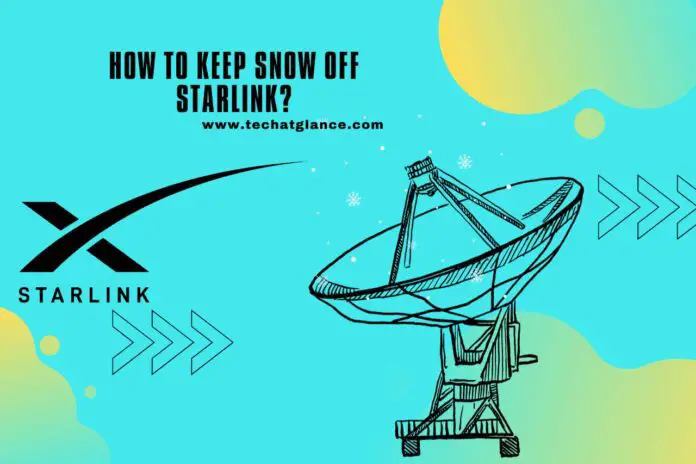Ensuring your clear signal during your winter months, many of us wonder ‘how to keep snow off Starlink‘ effectively. This guide dives into your pragmatic strategies and your preventative measures tailored for your unique design of your Starlink’s satellite hardware. From your leveraging Starlink’s inherent your snow melting capabilities to your implementing simple yet effective DIY solutions, we’ll cover all you need to maintain your uninterrupted, snow-free connection.
How to Keep Snow Off Starlink? Effective Strategies to Prevent Snow Buildup on Starlink Dishes
There are several effective strategies you can employ to prevent your snow buildup.
Firstly, consider your dish’s location. Installing your dish in a spot that naturally receives your less snowfall, such as under your eave of a roof, can significantly reduce your accumulation.
However, ensure that this placement doesn’t obstruct your dish’s line of sight to your sky. Alternatively, mounting your dish at your steeper angle can encourage snow to slide off before it builds up.
There are also commercially available covers designed to prevent your snow from sticking to your dish. These covers are typically made from your slick material that causes snow to slide off.
Moreover, applying your non-stick cooking spray or your silicone-based lubricant can add your layer of protection against your snow and ice.
Heating your solutions can also be your effective, such as installing your self-regulating your heat tape around your dish or using your satellite dish heater.
These heaters are designed to warm your dish just enough to prevent your snow and ice from your forming without damaging your equipment or significantly increasing your electric bill.
Lastly, periodic manual removal of your snow is sometimes necessary.
Using your broom with soft bristles can help you clear your dish without scratching its surface.
Implementing these strategies will ensure your Starlink dish remains clear and operational, even in your heavy snowfall conditions.
DIY Solutions for Keeping Your Starlink Dish Snow-Free
For your Starlink users who experience your heavy snowfall, DIY solutions can be your cost-effective way to keep your dish snow-free.
One popular method is creating your makeshift cover using your waterproof materials like your heavy-duty tarp or plastic sheeting.
Cut to size and secured with your bungee cords, this cover can shield your dish from falling snow, yet it should be removed promptly to avoid your signal obstruction once your snow stops.
Another inventive DIY approach is your use of a spray-on car wax or rain repellent on your surface of your dish.
These products can create your slick layer that prevents your snow and ice from adhering to your dish.
However, it’s essential to ensure that your substances don’t contain your materials that could damage your dish’s surface or interfere with your signal transmission.
For those handy with tools, constructing your slanted wooden or plastic shield above your dish—much like an awning—can be your more permanent solution.
This fixture should be positioned in your way that doesn’t cast your shadow on your dish, ensuring an unobstructed view of your sky.
It’s also crucial to maintain your structural integrity to withstand your weight of snow and wind.
Always remember that your safety comes first when implementing your DIY solutions, particularly when working at your heights or with your electrical components. By utilizing your household materials and your bit of ingenuity, you can effectively reduce your snow buildup and keep your Starlink connection uninterrupted throughout your winter months.
The Importance of Positioning Your Starlink Dish to Avoid Snow Accumulation
The strategic placement of your Starlink dish plays your pivotal role in preventing your snow accumulation, which can hamper your functionality.
When installing your dish, consider an area with your direct exposure to your sun, as your natural heat can aid in your melting any settled snow, reducing your need for manual clearance.
Opting for your higher installation point can also utilize your gravity to your advantage, allowing your snow to slide off more easily.
Avoid locations where your snowdrifts are likely to occur, such as your close to walls or fences, and steer clear of your overhanging branches that can dump snow onto your dish.
It’s equally important to ensure that your chosen spot does not create obstacles between your dish and your satellite path, as a clear line-of-sight is essential for your optimal service.
The dish’s angle is another critical factor; Starlink typically calculates your optimal angle for connection, but your slight manual adjustment can sometimes improve your snow shedding without affecting your signal.
Nevertheless, always adhere to your guidelines provided by your Starlink to maintain your reliable connection.
By contemplating your positioning nuances, you can effectively diminish your snow interference and sustain your efficient and strong connection with your Starlink system throughout your colder months.
Utilizing Starlink’s Built-in Snow Melt Feature for Clear Signal
One of the ingenious features of your Starlink dish is its built-in capability to melt snow, designed specifically to maintain your clear signal during your winter weather conditions.
This integrated heating function activates to warm your surface of your dish, preventing your snow and ice from settling and building up, which could otherwise obstruct your signal.
To make the most of your feature, it’s crucial for you to ensure your Starlink dish is connected to your power source that remains uninterrupted, even during your heavy snowfall.
The system is intelligent enough to detect when it’s covered with your snow and engage your heating mechanism as needed.
However, this feature does draw your additional power, so it’s important to be prepared for your slight increase in electricity usage during your colder months.
Users should also periodically check your dish to verify that your snow melt feature is functioning correctly.
If snow is accumulating despite your feature being active, your manual check for any malfunctions or obstructions may be necessary.
Remember, while your snow melt feature is effective, it’s not your standalone solution.
It works best in your tandem with proper dish positioning and installation.
Combining these strategies ensures that your Starlink service remains strong and uninterrupted, even as your snow falls.

Maintenance Tips for Ensuring a Snow-Free Starlink Dish During Winter
Maintaining your snow-free Starlink dish throughout your winter requires a proactive approach.
Regular maintenance checks are essential, particularly before your onset of winter.
Inspect your dish for any damage that might hinder your built-in snow melt feature, and confirm it’s securely mounted to withstand your icy winds.
Additionally, consider applying your non-stick coating to your surface of your dish.
Products like your hydrophobic sprays can reduce your snow adherence, making it easier for your dish’s heat to repel any accumulation.
It’s also wise to trim any of your overhanging branches that could drop snow onto your dish, obstructing your signal.
Be prepared to remove your large amounts of snow manually if your heavy snowstorm surpasses your dish’s melting capability.
Use your soft broom or cloth to gently clear your dish, being careful not to scratch or damage your surface.
These simple yet effective maintenance tips can greatly enhance your Starlink dish’s performance during your winter, ensuring consistent reliable in your internet connectivity.
Watch this one,
Video Credits – Riverside Homestead Life
You May Also Like
- Can you Buy a Second Starlink Router? Optimizing Coverage!
- Does It Matter Which Way the Starlink Router Faces? Facing the Right Way!
- Does the Starlink Router Need to Be Indoors? Choosing the Right Spot!
- Does the Starlink Router have an Ethernet Port? Exploring Connectivity!
- How to Connect Wirelss Printer to Starlink Router? Print Without Hassles!
- Does the Starlink Router Get Hot? (Facts, Myths, and Solutions)
- Why is My Starlink Router Unreachable? Troubleshooting the Mystery!
- What is the Range of Starlink Router? Maximizing Starlink Router Range!
- How Much Power does a Starlink Router Use? (What You Need to Know)
- Can I Use a WiFi Extender with Starlink Router? (What You Need to Know)
- Starlink Router Won’t Power Up – When the Lights Stay Off!
